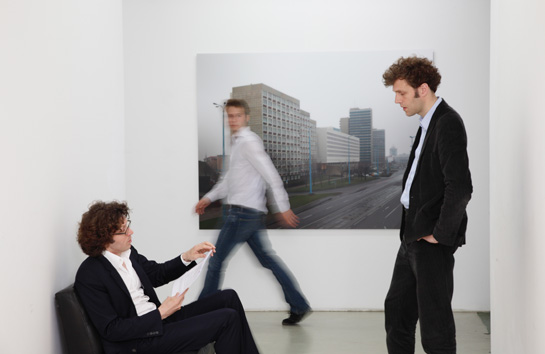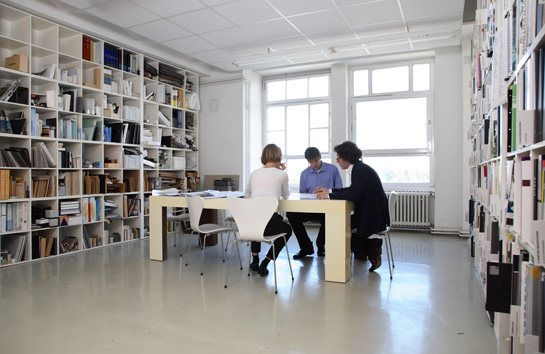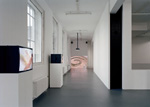
Profile




Johannes Kuehn, Wilfried Kuehn and Simona Malvezzi are better known in the art scene than among architects. No surprise, they think like artists.
The rooms in the Binding brewery were something special without, however, being particularly striking. Nowhere did the white fittings for “documenta 11” let on that they were made of plaster, were only temporary. Six years ago there art pilgrims did not so much wander through trade fair berths as typologically accurate and powerful series of rooms. Outside a white strip of light beneath scarred bricks denoted the entrance and was a distant reminder, albeit on another scale, of Herzog & de Meuron’s Tate Modern. The conversion for the “documenta” was the work of the architecture studio Kuehn Malvezzi. Since that conversion in Kassel and the one that followed in 2004 for the Friedrich Christian Flick Collection the architects have been everybody’s darling in the art scene. There has been, and indeed is, no end in sight to the series of conversions in art environments by Kuehn Malvezzi: the foyer of the Schirn in Frankfurt, rooms for the Manifesta in the Italian town of Trento, a viewable storage area in Vienna, several galleries, several art museums, many exhibitions.
Anyone who has long since got used to the idea of a museum being spectacular in design, attracting the masses, like a magnificent, meat-eating plant, finds it difficult to understand the Berlin studio’s success, it remains paradoxical. Rationalist, with no attention to details, no expressive ventures – is one way of describing Kuehn Malvezzi’s architecture. It does not cater to the global museum circus, but rather emerges from collaboration with artists, curators and collectors, in other words with art. Their primary goal is not the media marketability of the works, as is almost par for the course today but, at least as far as the studio’s previous building assignments are concerned, comes last. Kuehn Malvezzi’s conversions and fittings have the magnitude to withdraw, are unflustered and precise.


The words of Wilfried Kuehn are also unflustered and precise. The Professor of Exhibition Design and Curatory Practice at the Center for Art and Media (ZKM) in Karlsruhe is a blend of English reticence and southern European hairstyle. Together with his brother Johannes and the Italian Simona Malvezzi the 40-year old runs the Berlin-based studio, which has some ten employees. As the three partners are on the road a lot they communicate a lot by telephone. That, says Kuehn, requires a clear definition of goals, and concepts that can be described using the spoken word. The architects do not make any number of different versions but think the assignment and possible solutions through before getting down to more elaborate work – that I what is meant by «conceptual». Yet what Kuehn Malvezzi comes up with is not merely the impractical result of mind games. Wilfried Kuehn often refers to «context» and the «spatial dependence of perception». And if something is being built one just has to be present there. Like in Düsseldorf, where a year ago his studio completed the conversion work at the Julia Stoschek Collection – this too the transformation of a large historical industrial building into premises for contemporary art.
Every week the project leader traveled from Berlin to the Rhineland, even though the company was not responsible for the building work. Kuehn leads the way through the two spacious exhibition floors, which are only open to the public on Saturdays. Nowadays media art no longer means a screen and a black box. Elaborate installations seize control of all manner of different spatial situations. Elsewhere it is the museum, which nestles against it, places small compartments around the art, ensures that the noise of a video does not disturb the observation of the other works; all connected by a route that is consistent but by no means constrained, and if anything adds to the excitement. Kuehn Malvezzi are now masters in the creation of routes such as these. The architect says that the exchange of ideas with artists is important to them, and it was important to create spaces that challenge the art exhibited, give it emphasis as the observer passes by.
«Larger than life» –on entering Julia Stoschek’s studio one immediately thinks of the illusory worlds that Ken Adam created for James Bond; a residential hall the size of a triple sports hall and with its comfort as well. This space which, a hundred years ago, was used for painting stage sets, fills the steep, 12-meter high saddleback roof and for more than a year now has served the collector as her empire. The fact that this empire, like the museum levels below, are all in white is par for the course. The architects wanted to portray distinction and luxury not though high-end materials, but through space. And it does not even come to an end in the bedrooms on the mezzanine floor. On the crowning roof terrace a Dan Graham pavilion reflect the observer and the north of Düsseldorf. Below, Candida Höfer is just photographing the rooms. Next year she is producing a book and an exhibition with the architects.
Kuehn Malvezzi do not only build for art. They have also learned from it. From how artists proceed, their view, the artistic process. This becomes most evident in their more minor projects, where it was a case of making something visible. For example the Berlinische Galerie in Kreuzberg. A façade design was intended to draw attention to it. In the competition Kühn Malvezzi dissected the assignment and the location and came to the conclusion that a new façade would not produce the desired communication. Instead they placed a long, yellow field of letters on the ground in front of the building, as a playground and eye-catcher for the residents of the welfare housing opposite – art and living united in play. Or in Braunschweig where, for the Festival Theaterformen, the architects put a giant red staircase in front of the Classicist theater. With this caricature of an orchestrated element they gave the festival a logo, the building a new entrance and the visitors a new look out over their city.
Wilfried Kuehn sees himself not just as an architect, but also as a curator. He would like to establish the term «curatorial design», among other places at his university. «Curatorial design is not only to do with exhibiting, but with architecture and urban planning as well. What does it involve, apart from selecting and configuring?»
My attention was drawn to the team of architects at Kuehn Malvezzi in the art context. I was looking for a suitable team of architects to handle my private exhibition
building and repeatedly came across their name, which is why when tendering for the conversion of the house I also asked Kuehn Malvezzi to submit a design. In general there were three major challenges involved:
First, the gentle and careful handling of the historical, listed backbone to the house. Then the task of creating exhibition rooms destined to fit the special needs of media art, and specifically the linking/separation of private and public spaces.
Kuehn Melvezzi’s designs did a superlative job of addressing these three points and they concurred with my own notion of a “serving” architecture. The natural way in which the individual spatial elements link with the rest of the house and the clarity and restraint of thew spatial structure that was stringently maintained throughout the building prove to me that my decision was absolutely right, even today when I am busy preparing the next exhibition and thus for “life” in the house.
Julia Stoschek / Duesseldorf, Julia Stoschek Collection
Since first encountering their work in the Binding Brewery which they designed for the documenta show, I have found the combination of clarity and restraint coupled with stringency: the clarity of the spatial perception and the design of space, the restraint in the choice and use of architectural means, and the stringency with which, when handling the details and the overall issues, they give rooms an appropriate appearance.
Candida Höfer, Cologne, Photographer
As a very young architect Wilfried Kuehn responded to a tender to design the foyer of the Akademietheater in Vienna, the second venue used by the Burgtheater and he won out despite fierce competition from established offices. It was clear to me from our collaboration there that should I ever build something myself, I would the Berlin office Kuehn Malvezzi design it. Wilfried Kuehn was moreover the only person behind my idea of opting for a very difficult, very steep piece of ground and he developed an especially intelligent and brilliant design in the form of a house based on an open plan concept. In order to familiarize me with the concept of an open plan, he sent me to Prague to Adolf Loos‘ Müller Villa.
From the approach taken by the Kuehn Malvezzi office you soon see that they have their roots in exhibition architecture. First, they create the basic concept, then they face up to the restrictions. Here is where they are so different o many others, who first look at the problems and then propose comprised solutions. To exaggerate, the initial statement could be: Here, a great exhibition room has arisen. But where are the light switches and the power sockets and all those practical things? I personally found precisely
Kuehn Malvezzi’s approach very pleasant, as they did not first compromise, but took a free conceptual tack. Only then did they consider what makes an apartment different from an exhibition space. The result: a great design. Interestingly, it fascinates
everyone who has ever entered it – regardless of whether they see the house at the tender age of seven or seventy.
Thomas Drozda, Vienna
MD of Vereinigte Bühnen Wien and developer of Haus Drozda